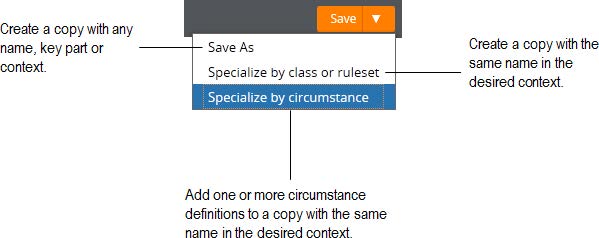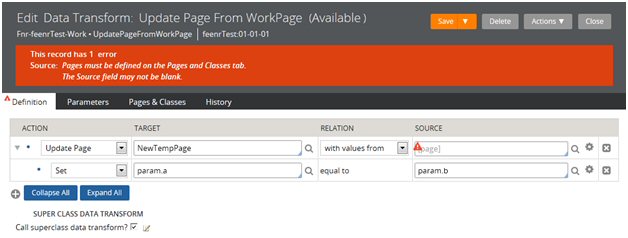Create, Save As, and Specialization forms
Valid from Pega Version 7.1.4
The familiar “New” and “Save As” forms have been streamlined to make record creation faster and more intuitive. You can easily target a specific layer in your application stack, interactively define the record’s configuration and select only those circumstance definitions that make sense for your use case.
While the underlying behavior for creating a record is not new for this release, the redesigned UI of these forms and new defaulting strategy for fields is worth noting:

To launch these forms, use one of the new options found in the action area of the form header:

Note that not all record types support the ability to specialize by circumstance.
For more guidance on how to use the Create, Save As and Specialization forms, please refer to: Intuitive record creation and specialization
Redirect users to logout screen
Valid from Pega Version 7.1.4
New applications built in Version 7.1 will automatically redirect users to the PRPC login page upon logout.
A new template, Web-Session-Return-Template, has been added, to allow developers to customize their applications to redirect users to a logout page, if they wish. This template can be copied to a ruleset visible to unauthenticated requestors (via node configuration) and used to override Web-Session-Return.
Source field not displaying in data transform
Valid from Pega Version 7.1.4
On the Data Transform rule form when using the Update Page action, if the Relation value is updated to “with values from”, the Source field will not be displayed.
(Note that for existing data transforms where the Source field has already been completed, this situation should not occur.)
Workaround
- Below is a data transform that has been configured to use Update Page.

- If a user were to choose an alternate source by updating the ‘with values from’ Relation value, they would not be prompted to provide a page name in the Source field.

- At this point, to be able to enter the Source page value, the user has to save the rule, which results in an error because the source page value is blank. This causes the field to appear.

- Once the field has appeared, the Source page value can be provided, and the form can be saved successfully.

Core Engine
Valid from Pega Version 7.1.4
This release contains fixes related to clipboard and declarative features, including data pages and autopopulate.
- A rule may be changed using Private Checkout, and then checked into a higher RuleSet Version for that RuleSet.
- Agents may now use a 24-hour time period for scheduling, as well as a 12-hour time period (which required the selection of AM or PM).
- Caching and performance have been enhanced.
- Declare expressions will work with embedded page lists when creating forms.
- Mandatory parameters on a data page can handle blank values.
- Properties may be auto-populated using a reference property which is created with a Property-Ref method in an activity.
- System will use "private edit" rules in developer's personal RuleSet when that rule overrides the "standard" rule available to all.
- The Page-Remove method will now remove Data Pages at the Thread level and the Requestor Level.
- When copying a page using the "Set" action on a data transform, the Declare Indexes defined on that data will be updated.
- When creating a data page, the Reload Once per Interaction checkbox can be checked to set the refresh strategy.
Decision Management
Valid from Pega Version 7.1.4
This release contains a number of fixes that improve the configuration and execution of Batch decisions – specifically, a number of usability improvements and addresses some issues when creating strategies on IE8.
- Batch Decision functionality has been enhanced in the NBAM environment.
- In NBAM, users can run the strategy execution batch based on the Seed list class instead of the customer class.
- Interaction data will now work even if Action or Organization dimensions do not have values set.
- Running a strategy which includes a Data Import of a structured page reference will work in batch mode.
- Security was enhanced on the VBD Planner.
- The Access of Role to Object rules have been enhanced to allow users to create new Dimension Operator records.
- The NBAM Segment On Canvas will now fetch the SegMap data, even when the generated extended segment class has not been added to the Pages and Classes of the strategy. The SegMap property will (if it exists) be added to a list of properties to fetch, even if the strategy indicates that it is not used.
- When a strategy is defined on a customer class, users may now specify the list of required properties to fetch for the input definition.
- When creating a new strategy, there is now a section to add a Strategy Results class like Business Issue or Group.
Designer Studio
Valid from Pega Version 7.1.4
Many refinements to the Designer Studio were made around performance and user experience. Based on feedback, we have made a number of bug fixes and strategic improvements that improve the overall user experience.
- The Developer Portal connects to the PDN's RSS feed without needing a DigiCert certificate for validation. The RSS feed is just headlines; to open and read any of the articles, users will still have to log into the PDN.
- Expression Builder has been enhanced to work with IE8.
- New applications built in Version 7.1 will automatically redirect users to the PRPC login page upon logout. A new template has been added, to allow developers to customize their applications to redirect users to a logout page, if they wish.
- Performance improvements were made when saving and validating rules.
- Performance of the Guardrails Dashboard has been improved.
- The display of circumstanced rules in Application Explorer has been enhanced.
Predictive models can drive predictions
Valid from Pega Version 8.6
You can use predictive models as the basis of your predictions. As a data scientist, you can now use Machine Learning Operations (MLOps) to replace models in your system. You can replace a model in a prediction with a PMML, H2O MOJO, or Pega OXL predictive model, as well as a scorecard or field, and then approve the update for deployment to a production environment. You can respond to a Prediction Studio notification that an active model does not generate enough lift and decide to replace the low-performing model with a high-accuracy model. You can also update a prediction on a regular basis, for example, whenever you develop a new churn model in an external environment.
For more information, see Replace models in predictions and migrate changes to production with MLOps.
Enhancing the performance of your Next-Best-Action strategy with globally optimized strategies
Valid from Pega Version 8.6
Starting in version 8.6, Pega Platform™ combines the versatility of Next-Best-Action Designer with strategy performance enhancements provided by using globally optimized strategies (GOS). Decrease the run time and memory usage of executing the Next-Best-Action strategy in batch or real-time scenarios by using the globally optimized strategies generated by Next Best Action Designer.
GOS is supported by Pega Platform's standard business change management process. GOS rules are automatically included in relevant revision packages.
For more information, see Enhance the performance of your Next-Best-Action strategy with globally optimized strategies (8.6).
Support for picklists with parameterized data pages in App Studio in Cosmos React UI
Valid from Pega Version 8.6
You can now use data pages with parameters to populate a property of the picklist type with filtered results in App Studio. For example, in a survey case type, you can use a parameterized data page to configure cascading drop-down controls in which the values in a secondary drop-down list are based on the value that the user selects in the primary drop-down list. With dynamically-sourced picklists, you get greater flexibility in configuring picklists, and users see more accurate values.
For more information, see link Dropdown control Properties — General tab.
Easier customer record management in Customer Profile Designer (early preview)
Valid from Pega Version 8.6
The new Customer Profile Designer module of Pega Customer Decision Hub™ makes it possible for marketing analysts and strategy designers to define the associated data for each customer context directly in the Pega Customer Decision Hub portal. It is also possible to define more complex associated data structures that use a custom data flow, or define associated data of different types, such as RDBMS and Cassandra, for the same customer context.
Customer Profile Designer is available in Pega Customer Decision Hub 8.6 version as an early preview version. The functionality will be further expanded in future releases.
For more information, see Manage customer records in Customer Profile Designer (8.6).

